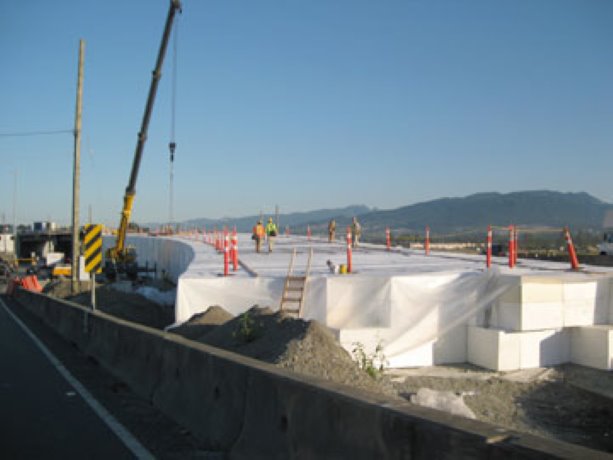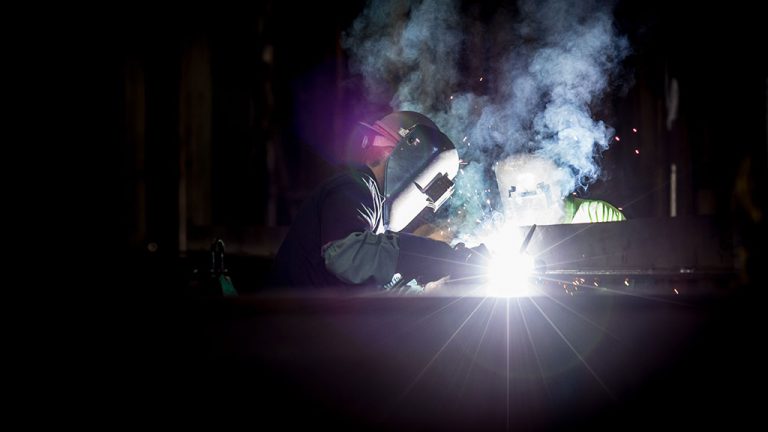The use of expanded polystyrene blocks is becoming more common on large-scale bridge or highway projects in B.C. and Alberta as contractors seek to deliver projects on time and on budget
Innovation
Looking like gigantic sugar cubes, geofoam or EPS (expanded polystyrene) blocks are becoming a trend on large-scale bridge or highway projects in B.C. and Alberta.
It’s use has grown as contractors work to bring in projects on time and on budget.
EPS is being used or has been used on the new Pitt River Bridge, the Golden Ears Bridge, the Coast Meridian Overpass, the new W. R. Bennett Bridge in B.C. and the Anthony Henday Drive Ring Road as well as the upcoming Spirit River road project in Alberta.
Until a decade ago, hogfuel was seen as an inexpensive lighter-weight fill material of choice, said David Harvey, senior bridge specialist for Associated Engineering responsible for the Pitt River Bridge.
However, hogfuel leachants stalled its popularity.
“When you use it in a concentrated zone, you need sheathing,” he said, but added that leaks still occurred and leachants reaching drainage system were found to be toxic.
Volcanic rock pumice, found in limited quantities in B.C., and also foaming concrete have been tried on smaller projects.
“The main use of geofoam is to reduce the loading of the embankment on the ground,” explained Kai–sing Hui, Trow geotechnical engineer for the embankments of the Golden Ears Bridge.
When heavier fills are loaded onto a site, the soil beneath must be able to withstand the weight of the embankment.
Lower levels of soil can be squeezed laterally or water gets squeezed out.
Either way, settling can occur over time and it can be detrimental.
Slumping can also occur in the road surfaces of highways.
To help with the problems, pre-loading is often done to mitigate shifting or decompression of soils, but it delays the start of construction and settlement can still occur afterwards.
Associated’s Craig Schaper, who has been involved in the Pitt River Bridge project, said that EPS on approach grades settles less as the years go by.
Geofoam is also being used more, said Schaper, because construction schedules are tighter as more projects today are design-build and contractors must finish on time.
Its popularity is “a recent phenomenon,” he said.
Hui said that on the Golden Ears bridge, EPS was used for the embankments providing a stable core for the bridge approaches and more.
“We also did something a bit ingenious,” he said.
Since the blocks stacked easily, the geofoam core allowed for the placement of facing, which not only provided a fire-proof seal, but an aesthetic-looking surface on three sides of the embankments.
Fire, oil and water are the drawbacks to using EPS.
Hui said to ensure the light-weight blocks don’t move in a flood, part of the design includes encasing them in sufficient mineral soils to keep them in place.
Gravel fill is normally placed over the blocks to spread the load before paving is done.
The material is also used in other ways.
Geofoam has also been used to protect underground utilities from traditional fill settling and breaking lines.
In Alberta, Beaver Plastics is a major supplier to the market.
Industrial products manager Robert Vasseur said it is being used on bridge abutments on the Henday Drive Ring Road.
“The owners, a consortium, are responsible for maintaining the road (over the next 20 years before it reverts to the province),” he said.
“It is being used to create a void for future use, so if the bridge needs to be widened, they can go in and remove the geofoam and drill for the new piles,” he said, adding it’s much cheaper than removing fill materials.
On Alberta’s Spirit River highway project there are two deep valleys that need crossing.
The blocks will provide a less costly way to build the bridge abutments compared to using fill that would have to be trucked to the area.
Work is expected to start next year.
One of B.C.’s largest suppliers of EPS is Mansonville Plastics (BC) Ltd., which has its own installation crews for projects.
“We worked on the Golden Ears Bridge and right now we are doing the Pitt River Bridge,” said Nick Micona, who specializes in geofoam sales.
Crews on the Pitt River Bridge project have been working 8 p.m. to 8 a.m. over the summer months on the highly-visible project.
“They are using 20-30,000 cubic metres (of EPS) in four different locations (two on each side of the bridge),” he explained.
Mansonville crews are also working on one side of the Coast Meridian Overpass in Coquitlam and will finish the other in September.
Micona said that EPS use is gaining traction because companies are building in areas where traditionally the soil is poor, as better sites have been exhausted.
These sites require new solutions.
“You can replace one million pounds of gravel with 5,000 pounds of foam,” he said.
Use of geofoam continues to grow
While Western Canada is starting to see more EPS (expanded polystyrene) use, it is common in Japan, Scandinavian countries and the U.S.
An excellent resource about the subject is the Geofoam Research Centre in New York, which is part of Syracuse University.
Its website provides information on projects and research initiatives around the globe.
In B.C., geofoam started appearing more than a decade ago on projects such as the Pat Bay Highway, the Stave Lake Bridge and the Roger Pierlet Bridge in Cloverdale.
More recent applications include the Golden Ears Bridge project, the Howe Street Overpass in New Westminster and Richmond’s Olympic Oval.
When used to build overpasses on softer ground, it can actually prolong life by 15-20 per cent.











Recent Comments
comments for this post are closed